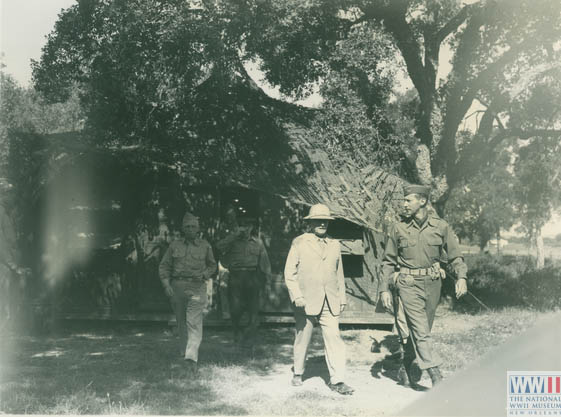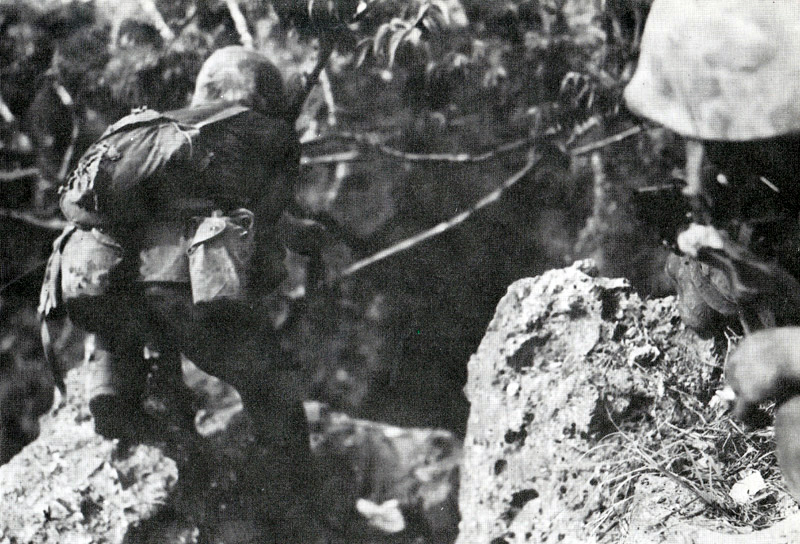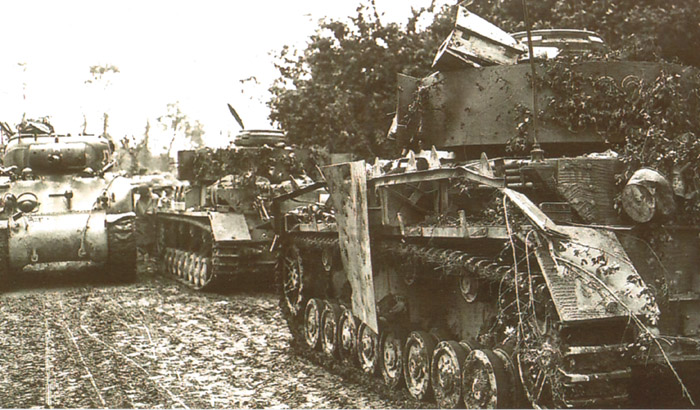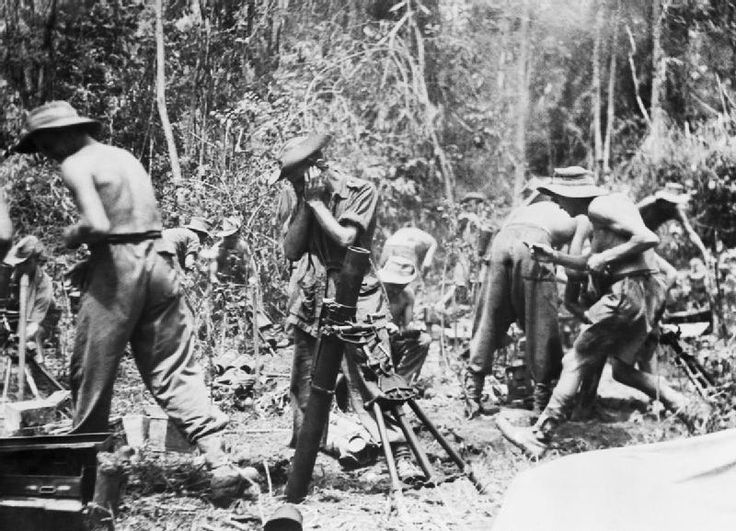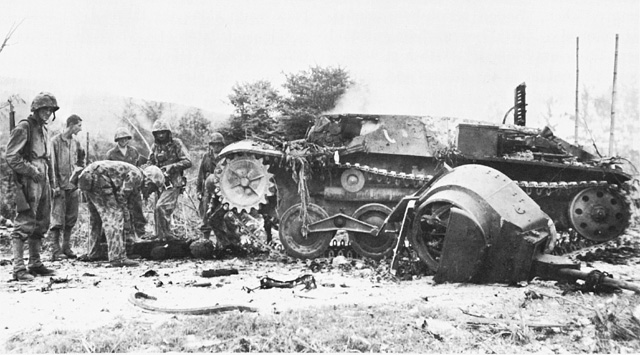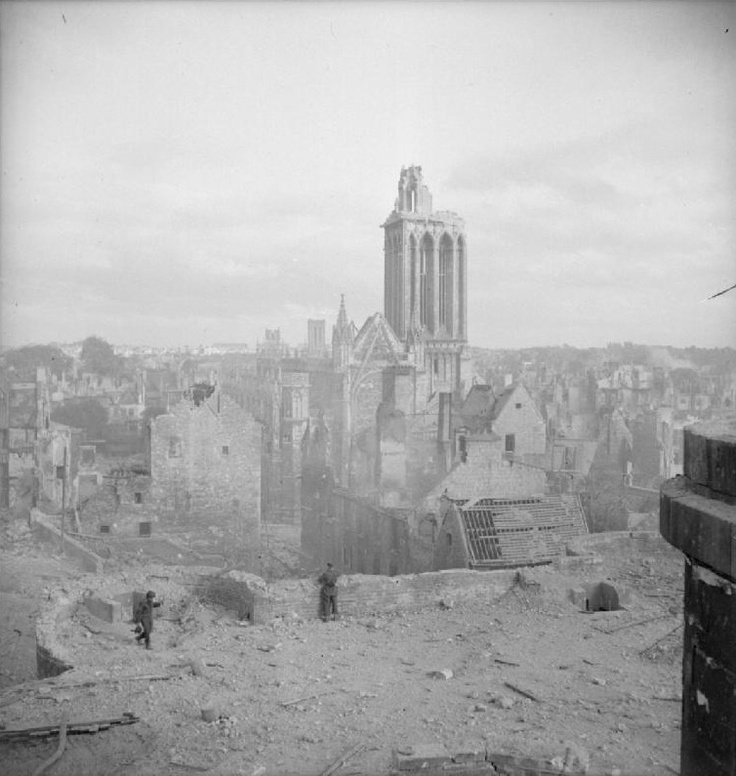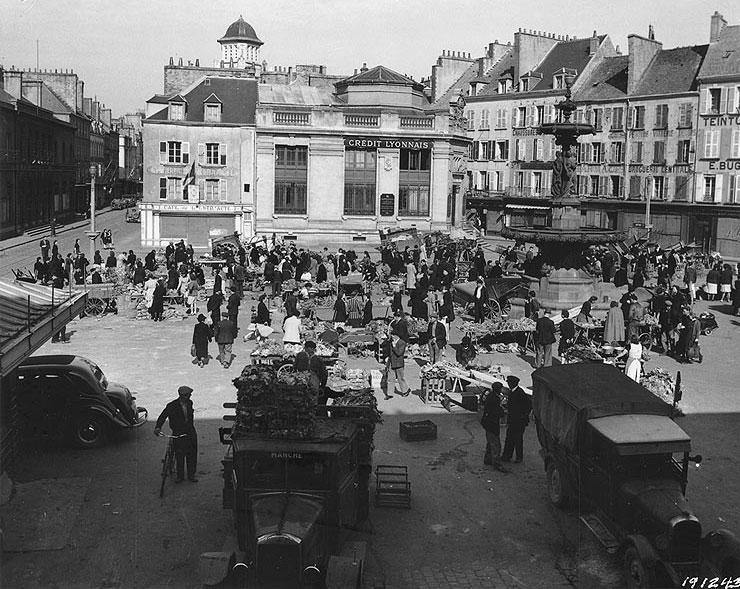Air Operations, Asia
A second raid is carried out on the Japanese metropolitan islands by US Superfortresses. The B-29s concentrate their attack on naval installations at Sasebo, in Kyushu Island.
[Air Operations, Europe
RAF BOMBER COMMANDDaylight Ops:
- 467 aircraft of Nos. 1, 4, 6 and 8 Groups are involved in a major effort to assist the land battle. Included in the aircraft total are 283 Lancasters, 164 Halifaxes and 20 Mosquitos. The Canadian 1st and British 2nd Armies are held up by a series of fortified village strongpoints north of Caen. The first plan is for Bomber Command to bomb these villages but, because of the proximity of friendly troops and the possibility of bombing error, the bombing area is moved back nearer to Caen, covering a stretch of open ground and the northern edge of the city. The weather is clear for the raid, which takes place in the evening, and two aiming points are well marked by Oboe Mosquitos and other Pathfinder aircraft. The Master Bomber, Wing Commander S. P. (Pat) Daniels of No. 35 Squadron, then controls a very accurate raid. Dust and smoke soon obscure the markers, but the bombing always remains concentrated. 2,276 tons of bombs are dropped.
- It is afterwards judged that the bombing should have been aimed at the original targets. Few Germans are killed in the area actually bombed, although units near by are considerably shaken. The northern suburbs of Caen are ruined.
- No German fighters appear and only 1 Lancaster, of No. 166 Squadron, is shot down by flak. 2 further Lancasters and 1 Mosquito crash behind the Allied lines in France.
- 208 Lancasters and 13 Mosquitos from No. 5 Group with some Pathfinder aircraft attack a flying bomb storage dump in a group of tunnels at St Leu d'Esserent. The bombing is accurately directed on to the mouths of the tunnels and on to the approach roads blocking access to the bombs stored there. German night fighters intercept the force and cause heavy casualties.
- 29 Lancasters and 2 Mosquitos are lost. No. 106 Squadron, from Metheringham, loses 5 of its 16 Lancasters on the raid and No. 630 Squadron, from East Kirkby, loses its commanding officer, Wing Commander W. I. Deas, who was flying his 69th operation. Wing Commander Deas was killed and is buried in a small cemetery at Omerville, north-west of Versailles.
- 123 Lancasters and 5 Mosquitos carry out an accurate raid on the railway yards at Vaires without loss.
- 106 aircraft of Nos. 1, 3, 5 and 9 Groups carry out a diversionary sweep almost to the coast of Holland in support of the St Leu d'Esserent raid and 7 Mosquitos drop spoof markers.
- 32 Mosquitos are sent to Berlin and 9 to the Scholven/Buer plant, 83 Mosquitos are on patrols and there are 48 aircraft on RCM sorties or Resistance operations.
- 2 Mosquitos are lost on the Berlin raid and 1 aircraft on a Resistance operation.
GERMANY:
- 939 9th Air Force B-17s and B-24s, escorted by 656 VIII Fighter Command fighters, attack three synthetic-oil plants, eight aircraft-assembly plants, marshalling yards at two locations, and equipment depot, railway repair shops, a railroad stations, and two airdromes in central Germany.
- 37 heavy bombers are lost, 390 are damaged
- 166 escort fighters strafe airfields and rail targets.
- VIII Fighter Command escort pilots down 77 Luftwaffe aircraft over Germany between 0830 and 1045 hours.
- 6 escort fighters and their pilots are lost
FRANCE:
- More than 100 IX Bomber Command B-26s and A-20s attack rail bridges near Tours and targets of opportunity around Beauzeville and Lisieux.
- More than 500 9th Air Force fighters and fighter-bombers patrol the beachhead area and bomb and strafe a broad variety of tactical and communications targets in western France.
- IX TAC fighter pilots down 8 Luftwaffe fighters over France between 0930 and 2025 hours.
- During the night, to help alleviate the V-1 terror attacks on targets in England, 32 B-26s from the IX Bomber Command's 322nd Medium Bomb Group are dispatched to attack the V-weapons headquarters at Chateau de Ribeaucourt. Alerted by radar, Luftwaffe night-fighters, some using flares, down 9 B-26s. Bomber gunners down 1 single-engine night fighter and 1 Ju-88.
ITALY:
- 12th Air Force B-25s and B-26s attack rail bridges and a fuel dump.
- XII TAC A-20s attack several fuel dumps.
- XII TAC fighter-bombers attack the Ferrar Airdrome, a town, ammo dumps, and various tactical and communications targets.
- During the night, XII TAC A-20s attack several defended towns.
CZECHOSLOVAKIA:
- 15th Air Force B-24s attack an armaments factor at Dubnica.
- 15th Air Force B-17s and B-24s attack two synthetic-fuel plants at Blechhammer, and B-24s also attack a synthetic-fuel plant and a coke plant at Odertal.
- Escort pilots from the 52nd, 82nd and 325th Fighter Groups down 13 Axis fighters along the bomber routes between 0950 and 1240 hours.
- 18 15th Air Force aircraft are lost on the day's various missions
- 15th Air Force B-24s attack the airdrome and marshalling yards at Zagreb.
CBI
BURMAThe British 36th Division, which has moved forward to replace the 77th Long Range Penetration Brigade, Indian 3rd Division, is transferred to the command of Gen Stilwell.
In the NCAC area, the Myitkyina TF begins a training program for forces in reserve and those in contact with the enemy.
On the Salween front, the Chinese 8th Army continues operations to clear Sung Shan with a night attack on the 7th, by the 246 Regiment of the 82nd Division. Although the peak is seized, the Japanese counterattack and drive the Chinese off causing about 200 casualties.
[Eastern Front
North of Lake Ladoga, the Finns complete their retreat to the 'U' Line.
SOUTHERN SECTOR
The 1st Belorussian Front begins limited attacks with its 47th Army, taking Kovel after hard fighting.
[France, Politics
The former Cabinet Minister and anti-collaborationist, Georges Mandel, is executed at Fontainbleu on the orders of the Vichy police chief, Darnand.
[Italy
Units of the US 34th Div take Pignano in their advance up the Tyrrhenian coast. Rosignano is captures by the 135th Regt of the 34th Div. The Germans rearguards have not yet yielded, however, and they take up positions just outside the town. The 4th Mountain Div of the French Expeditionary Corps takes Val d'Alsa hill.[ITALY]
[Marianas
SAIPANAt first light practically the whole of the Japanese garrison, now reduced to about 3,000 men, mount a wild attack on the American lines south of Makunsha Village. They sweep through the 105th Infantry Regiment of the 27th Infantry Division and the guns of the 3rd Battalion of the 10th Marines. There is bitter hand-to-hand fighting before the attack is stopped at the 105th Infantry Command Post. Toward the end of the morning an American counterattack by the 106th Infantry recovers most of the lost ground and drives the Japanese back as they are pursued northward with terrible losses. Over 900 soldiers and marines are killed.
Meanwhile, the 165th Infantry clears Harakiri Gulch without serious opposition. The 4th Marine Division continues to make rapid progress on the right.
[New Guinea
On Biak, a company of the 163rd Infantry attempts to move into the Ibdi Pocket but finds the enemy repairing old fortifications and building new ones. Bombardment of the position is resumed.
[Occupied Denmark
A Danish mechanic with no pilot training steals an He-111 and flies it to Sweden. He is shot down by Swedish flak.
[Pacific
- Adm Nimitz orders his commanders in the field to prepare forces for an invasion of the southern Palau Islands, Angaur, Peleliu and Ngesebus, on September 15 and of Yap and Ulithi, northeast of the Palaus, on October 5.
- US submarines sink 2 Japanese destroyers, the Usugumo by the Skate (SS-305) around the Kurile Islands and the Tamanami by the Mingo (SS-261) in the South China Sea.
- The US submarine Bonefish (SS-223) sinks the Japanese guardboat Ryuei Maru off Tarakan, Borneo.
- The US submarine Flasher (SS-249) sinks the Japanese transport No.2 Koto Maru (3557t) off Cape Varella, French Indochina.
- The US submarine Sunfish (SS-281) attacks a group of Japanese fishing boats en route from Matsuwa to Uruppu, sinking No.5 Hokuyo Maru, No.5 Kannon Maru, Ebisu Maru and Kinei Maru.
United States, Planning
Adm Nimitz redraws plans for the attack on the Palaus, changing the name of the operation from STALEMATE to STALEMATE II. The target date for the invasion is reset for September 15. Because the battles at Guam and Saipan have involved army and marine forces for far longer than originally planned, the III Amphibious Corps (1st Marine Division and 81st Infantry Division) are tasked with capturing Peleliu and Angaur. To prevent any Japanese interference with the Palau operation, Iwo Jima, Chichi Jima, and Yap are to be attacked to eliminate Japanese air forces.
[Western Front
In the west the 79th and 90th Divs of the American VIII Corps continue their efforts to break through the defensive line between La Haye-du-Puits and Mont-Castre-Forest, but have to withstand violent counterattacks. Units of the American VII Corps move slowly along the Carentan-Pèriers road against growing opposition by 2 SS divisions, the 2nd and 17th Pzr. East of the American VII Corps, the US 30th Div of the XIX Corps establishes a bridgehead near the village of St Jean-de-Daye, which they capture, and then push on towards the Vire River. The German opposition is still formidable.[WF]
The British battleship Rodney shells German positions around Caen in preparation for the imminent British attack.[CAEN]
[Images from July 7, 1944
|
|
|
|
|
|
|
|

